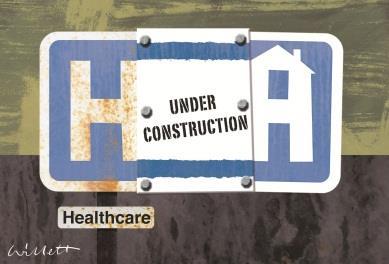Hospitals play only a small part in determining population health outcomes, which is why reconfiguration can only go so far in improving them, writes Candace Imison

In a recent editorial for The BMJ, Nigel Edwards argues that “the quality of debate about the role of hospitals has improved”. He cites the work of the Royal College of Physicians’ Future Hospital Commission and the NHS Five Year Forward View. Both have moved away from an “all or nothing” approach to the future of acute hospital care and envisage hospitals that are more integrated with primary and tertiary care.

‘Hospitals are part of a web of care stretching from the patient’s home to the most specialist tertiary level service’
The King’s Fund hopes to enhance the quality of that debate even further with the publication of a major report laying out the evidence available to help guide the reconfiguration of hospital services. The evidence supports the direction of travel suggested by NHS England and the RCP, in particular that there are increasing opportunities to sustain services in smaller hospitals. We need to grasp these opportunities if we are to provide a model of hospital care that recognises the huge demographic shift currently under way.
We argue that hospitals are part of an interconnected web of care stretching from the patient’s home to the most specialist tertiary level service. Clinical networks and new technologies offer opportunities to strengthen that web and deliver more coordinated care.
Those planning services need to look across that web to ensure the most efficient distribution of services, to remove duplication, and to ensure that patients receive the right care in the right location at the right time.
- Building future NHS organisations starts with citizens
- The future for specialists is beyond a hospital’s four walls
- Dalton’s plans to revitalise provider sector unveiled
Gaps in the evidence
However, our research highlights major gaps in the evidence. For example, saving money is one of the top two reasons given for reconfiguration, yet there is no evidence that reconfiguration will save significant sums of money either through centralising hospital services or replacing them with community services.
Workforce is the other primary driver for service change – for example, the desire to move from a consultant led to a consultant delivered service. While there is strong evidence to support the benefits of more consultant delivered care, particularly for high risk patients, there is little evidence to say how many senior staff are needed, of what type and for what time periods.
‘We need to recognise that hospitals play only a minor part in determining population health outcomes’
There is good evidence to support the centralisation of many specialist services. For example, there is evidence that outcomes for vascular surgery can be improved through centralisation. However, the benefits rely on much more than a simple link between volume and outcomes. The ways of working within and across specialties can be just as important (a message that is true for all services, specialist or not).
For example, systematic use of the World Health Organization’s surgical safety checklist (Haynes et al 2009, de Vries et al 2010) can reduce complication rates from surgery by over a third and deliver reductions in absolute mortality that are comparable with those achieved from the reconfiguration of stroke services in London (Morris et al 2014).
Above and beyond this we need to recognise that hospitals play only a minor part in determining population health outcomes. For example, a recent major randomised control trial of patients at high risk of cardiovascular disease, including stroke, showed that following a Mediterranean diet supplemented with nuts nearly halved the rate of stroke in this group (Estruch et al 2013). If this happened in London, many more lives would be saved than was achieved through the reconfiguration of stroke services.
As we say in our report, the reconfiguration of health services is an important but insufficient approach to improving healthcare and outcomes.
Candace Imison is deputy director of policy at the King’s Fund. A version of this article also appears on the King’s Fund blog.The report referred to in this article draws on research funded by the National Institute for Health Research (NIHR) Health Services and Delivery Research Programme (project number 12/5001/59).



























1 Readers' comment